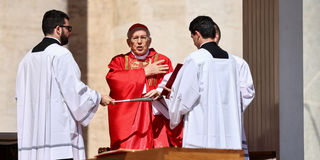Premium
‘His last appearance was a sacrifice’: Highlights of the sermon delivered at Pope Francis’ burial

Cardinal Giovanni Battista Re leads the funeral Mass of Pope Francis in St. Peter's Square at the Vatican, April 26, 2025.
What you need to know:
- The cardinal selected a number of exemplary attributes of the late pontiff.
- Cardinal Re used anecdotes of Pope Francis’ life to preach about the ideal life.
Cardinal Giovanni Battista Re, the dean of the College of Cardinals, lavished Pope Francis with praise in his sermon delivered at the funeral Mass held at St Peter’s Basilica on Saturday.
It was a Mass where the name of Pope Francis was mentioned at least 24 times at various stages, with Cardinal Re mentioning him at least 15 times in his homily.
The cardinal selected a number of exemplary attributes of the late pontiff. Building on the Bible reading from the story of Peter and his encounter with Jesus after the latter had died and resurrected, Cardinal Re used anecdotes of Pope Francis’ life to preach about the ideal life.
Below are the highlights of the 91-year-old’s sermon, which he delivered in Italian.
1. Pope Francis didn’t fear visiting dangerous places
“Of his 47 arduous apostolic journeys, the one to Iraq in 2021, defying every risk, will remain particularly memorable. That difficult apostolic journey was a balm on the open wounds of the Iraqi people, who had suffered so much from the inhuman actions of ISIS. It was also an important trip for interreligious dialogue, another significant dimension of his pastoral work,” said the cardinal.
2. His Easter Sunday appearance was “an act of sacrifice”
“The final image we have of him, which will remain etched in our memory, is that of last Sunday, Easter Sunday, when Pope Francis, despite his serious health problems, wanted to give us his blessing from the balcony of St Peter’s Basilica. He then came down to this Square to greet the large crowd gathered for the Easter Mass while riding in the open-top Popemobile,” said the Cardinal.
“Despite his frailty and suffering towards the end, Pope Francis chose to follow this path of self-giving until the last day of his earthly life. He followed in the footsteps of his Lord, the good shepherd, who loved his sheep to the point of giving his life for them,” he added.
3. He insisted on reconciliation
“Faced with the raging wars of recent years, with their inhuman horrors and countless deaths and destruction, Pope Francis incessantly raised his voice, imploring peace and calling for reason and honest negotiation to find possible solutions. War, he said, results in the death of people and the destruction of homes, hospitals and schools. War always leaves the world worse than it was before: it is always a painful and tragic defeat for everyone. ‘Build bridges, not walls’ was an exhortation he repeated many times, and his service of faith as successor of the Apostle Peter always was linked to the service of humanity in all its dimensions,” said the cardinal.
4. He cared for immigrants and the lowly
“It is significant that Pope Francis’ first journey was to Lampedusa, an island that symbolises the tragedy of emigration, with thousands of people drowning at sea. In the same vein was his trip to Lesbos, together with the Ecumenical Patriarch and the Archbishop of Athens, as well as the celebration of a Mass on the border between Mexico and the United States during his journey to Mexico,” the Cardinal told the gathering of hundreds of thousands.
“He established direct contact with individuals and peoples, eager to be close to everyone, with a marked attention to those in difficulty, giving himself without measure, especially to the marginalised, the least among us. He was a Pope among the people, with an open heart towards everyone,” added the cardinal.
5. Pontiff viewed the church as a healing place
“[He had the] conviction that the Church is a home for all, a home with its doors always open. He often used the image of the Church as a ‘field hospital’ after a battle in which many were wounded; a Church determined to take care of the problems of people and the great anxieties that tear the contemporary world apart; a Church capable of bending down to every person, regardless of their beliefs or condition, and healing their wounds,” said Cardinal Re.
6. The pontiff used many language devices
“With his characteristic vocabulary and language, rich in images and metaphors, he always sought to shed light on the problems of our time with the wisdom of the Gospel. He did so by offering a response guided by the light of faith and encouraging us to live as Christians amid the challenges and contradictions in recent years, which he loved to describe as an ‘epochal change.’ He had great spontaneity and an informal way of addressing everyone, even those far from the Church,” the Cardinal said.
7. He always asked Christians to pray for him
Said Cardinal Re: “Pope Francis used to conclude his speeches and meetings by saying, ‘Do not forget to pray for me.’ Dear Pope Francis, we now ask you to pray for us. May you bless the Church, bless Rome, and bless the whole world from heaven as you did last Sunday from the balcony of this Basilica in a final embrace with all the people of God.”


